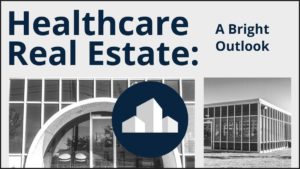The 9 Biggest Mistakes You Can Make When Investing in Medical Office
With cap rates compressing among other property types, a growing number of real estate investors are turning to medical office in search of yield. Indeed, there are many reasons to be bullish about the sector, from supportive demographics to continued rent growth.
Yet medical office, as an asset class, is more nuanced than other commercial real estate product types. The demand drivers are different. Tenanting the spaces is more complicated. Even the construction and the fit-out of the spaces is highly specialized (and costly!). While investors are certainly encouraged to consider adding medical office to their portfolios, they should do so in a disciplined manner.
While the list below may apply equally to many other real estate asset classes as well, they just have their own important nuances in MOB that can lead to investor mistakes. Here are some of top mistakes investors make when first investing in medical office real estate.
1. Blindly following the lead of other investors.
It’s not uncommon for real estate investors to take advice and direction from their peers. For instance, someone will be at a cocktail party and will mention how well their medical office investment is going and then others quickly follow suit. This can lead to someone investing in medical office without first understanding the sector’s nuances. Worse, someone may purchase a MOB property outright (instead of passively investing with a sponsor) and then they’re surprised by how much they don’t know about this asset class – even if they have previous experience with investing in commercial real estate.
Instead, those who are interested in adding medical office to their portfolios are better off being led by someone who knows the market, knows what’s driving demand in that specific locale, knows the trends associated with MOB facilities, etc. Investing along an experienced MOB sponsor is a great way for real estate investors to diversify their portfolios, but in a calculated way that reduces the chance of surprises (or major costs) down the road.
Subscribe to our commercial real estate newsletter.
2. Not understanding the local demand drivers.
Demographics are an incredibly important driver of demand for medical office buildings. Baby Boomers, the nation’s largest demographic, are starting to turn 65 years old. This is the age when demand for healthcare begins to increase (it is not until closer to age 85 that people begin to need more specialized care in assisted living communities). The second largest demographic is the Millennials, or those born between 1980 and 2000.
This group is starting to have families of their own, which drives demand for family medicine and other routine care. Before investing in a medical office property, it is important to know who is driving demand for MOB in that area. The demographics will influence not only total demand for MOB, but type of MOB facilities. For example, Baby Boomers are likely to need orthopedic care and cardiac care more so than other specialties. This influences how MOB facilities are tenanted; investors want to be sure they are buying MOB properties that are leased to providers whose services are needed by the local population.
Moreover, investors should take inventory of the other medical providers in the area. They should know, for example, what the hospital systems are in the area in which they’re considering an investment. The size, type and quality of the local hospital system(s) can impact both the demand for and value of MOB properties.
3. Forgetting to interview the tenants.
Physicians tend to be brutally honest and provide tremendous insight to prospective MOB investors. Investors who are considering a deal should tour the property in-person and request from the seller that tenant interviews are a requirement during the due diligence period of a transaction. Then, sit down with some (if not most) tenants. Ask them how they like being a tenant in the property. Ask them for feedback about what could be changed. You may find, for example, that simple improvements – like air conditioning leveling – would make the tenants happier.
The tenants may also reveal larger, more systemic problems like concerns about the janitorial service, cleanliness, or responsiveness of the management company. These conversations may also reveal whether a tenant is likely to renew a lease if there is a lease expiration on the horizon (and if the tenant is planning to leave, whether there is anything a new owner could do to prevent that from happening).
When considering an MOB property, investors should think of themselves as getting into business with the tenants. MOB facilities are so specialized that the landlord and tenants become true partners—the success of the tenants directly influences the profitability of the investment.
4. Overlooking important lease terms.
It is essential that investors closely read all existing lease documents associated with the property. These lease documents contain information like the lease term, expiration dates, options to renew, and who is responsible for various property improvements. Too often, investors overlook lease agreements and in doing so, run the risk of investing in a building in which the leases are all set to expire on or around the same time. If that happens, and tenants decide not to renew, the landlord could be faced with widespread vacancy and a drop-off in cash flow.
Moreover, if these spaces are outdated, the landlord could be on the hook for costly upgrades or repairs needed to re-lease the space at competitive terms. Prospective investors should always read the lease agreements and should pay close attention to lease terms. Ideally, a multi-tenant medical office building will have staggered leases to minimize the risk of widespread vacancy.
5. Underestimating the cost of capital improvements.
Real estate investors generally understand the cost of capital improvements, but medical office buildings have specialized equipment and systems that can drive these costs even higher. For example, depending on the physician’s specialty, a healthcare provider may need specialized AC units or back-up power generators.
Depending on how a lease is written, these costs may be shared between the landlord and tenant – they may also fall to one party, either the landlord or the tenant, which is why it is important to carefully read all lease documents prior to investing (see above).
Capital improvements may also be necessary when renovating and re-leasing a space. Typically, any capital improvements that exceed a certain portion (square footage) of the total property or exceed a certain dollar amount will trigger the need for the building to become fully ADA compliant. Adhering to new ADA requirements can be very expensive. Investors should look at whether the existing space is already ADA compliant and if not, what it would cost to make these upgrades now or in the future.
6. Ignoring local zoning and ordinances.
Most municipalities have specific rules and regulations that govern how specific properties can be used. MOB facilities tend to have especially high parking needs, usually at least 5 parking space per 1,000 square feet of medical office space. Having sufficient parking is always a concern among existing and prospective MOB tenants.
Prospective investors should understand what sort of zoning restrictions exist and whether the MOB facility in question has been “grandfathered in” under old zoning to allow for certain uses, parking provisions or other activities to remain as-is (and conversely, understand what could potentially trigger losing that exemption, such as a major renovation or expansion of the existing facility).
7. Trying to self-manage the property.
Historically, many smaller scale MOB properties are owned by physicians who operate their practice out of the space. Physicians typically get excited at the prospect of owner-occupying MOB space, only to find that self-managing a property can be challenging. This is especially true given the time constraints physicians and other healthcare providers already feel. Managing an MOB property can be very time intensive. For example, a prospective tenant might be running late to tour the space or a maintenance vendor may be late which, in turn, makes the physician late for their scheduled appointments.
Physicians who plan to continue practicing medicine, at least for the foreseeable future, are usually better off with one of two courses of action: either a) outsource property management to a third-party; or b) sell and lease back the property from someone else.
Outsourcing property management obviously comes at a cost, but the management company can make owning a property seamless for the owner. They will meet with vendors, prospective tenants, etc. at all hours of the day, which takes the burden off of a physician who has an otherwise tight schedule. It also helps to reduce decision-making conflicts when someone has invested alongside friends and family. A property management company can make informed decisions in the best interest of the ownership group, freeing the investors from any debate amongst each other that could otherwise cause a standstill.
Sale-leasebacks are also common in the medical office space. Many physicians who own their MOB property have significant equity in those buildings. Physicians who want to tap that equity but who understandably do not want to relocate their practice may instead decide to sell their building and then lease back, generally for five- to ten-year terms, which provides access to the equity while freeing up the more burdensome management responsibilities.
8. Not running the property like a business.
The whole point of investing in a medical office building is to earn additional income. Too often, individuals (especially physicians) will purchase a MOB with friends and family. However, none of them have a strong grasp on how to manage the property effectively. Costs start to escalate. Necessary repairs and maintenance fall by the wayside. Vacant spaces remain vacant for too long. Rent collections start to slip and total cash flow begins to tumble.
Again, this is where a property manager can be worth their weight in gold. Outsourcing management to a third-party will ensure the property is run like a business. Management will provide general oversight, from accounting and bookkeeping to financial reporting. They will chase late rent payments, tend to property improvements, and will draw on their industry experience to keep costs down. In short, while there is a cost associated with hiring a property manager, professional management is the best way to maximize investors’ returns.
9. Having unrealistic expectations.
Even the most experienced real estate investors may still have a lot to learn about the nuances of medical office investing. A common pitfall is for someone to invest, having heard a story or two about a friend earning a tremendous return on a specific MOB deal, and will expect to earn the same type of returns when they invest in another MOB opportunity.
In reality, medical office is a very particular asset class that distinguishes it from other product types. There are many factors, such as the type and location of the MOB, that can influence how well it performs. Just because someone realized a certain cap rate on one deal does not mean that all MOB properties will have the same success.
Cap rates can also be influenced by where we are in the market cycle, the strength of the tenants, and cash flow strength. Investors should spend time learning about the asset’s specifics during the due diligence period to ensure they set their expectations accordingly—and not simply based on some other MOB investor’s previous success.
CONCLUSION
Medical office can be a tremendous addition to investors’ real estate portfolios. This in-demand, recession-resilient product type is especially attractive for those in search of yield. However, success with medical office is not guaranteed. Too often, investors jump on the medical office bandwagon without first understanding the unique characteristics of this property type.
Anyone who is considering an MOB investment should be sure to do their homework in advance. Learn about the market, the demand drivers, and the trends specific to that region as well as the sector as a whole. Learning the nuances of MOB properties can take time, and therefore, someone interested in investing today might instead consider investing alongside an adept MOB sponsor who can guide them through the process.
Are you interested in investing in medical office? Contact us today to learn how our platform provides best-in-class MOB opportunities to first-time and seasoned real estate investors alike.
POSTED BY
Trisha Talbot
Managing Principal | DOCProperties
 Trisha Talbot advises physician owners and investors with opportunities in the healthcare real estate asset class. Her track record in investment sales, landlord representation, corporate representation and tenant representation offers clients trusted experience with comprehensive strategies with pricing, market fluctuations and problem solving solutions that result in successfully close transactions.
Trisha Talbot advises physician owners and investors with opportunities in the healthcare real estate asset class. Her track record in investment sales, landlord representation, corporate representation and tenant representation offers clients trusted experience with comprehensive strategies with pricing, market fluctuations and problem solving solutions that result in successfully close transactions.



